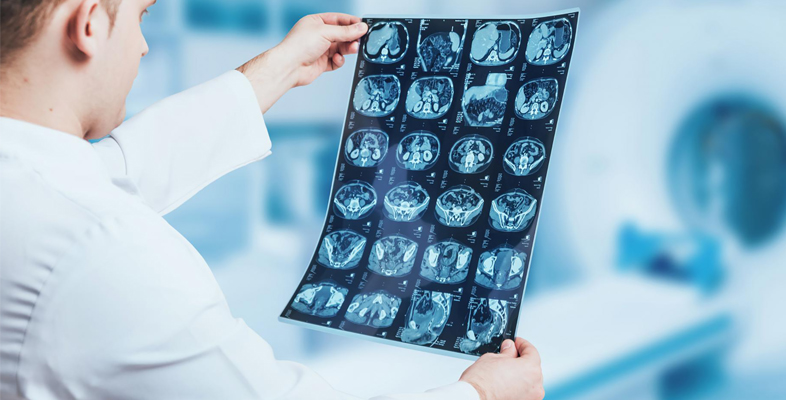Spatial localisation
A magnetic field gradient is applied across the body in three directions. This means that the external magnetic field experienced by a proton depends on where in the body it is situated. And when a proton returns to the ground state, the energy emitted will depend on the position of that proton in the magnetic field gradient and hence on its location in the body.
Figure 8 gives you a simplified view of how spatial localisation works.

Consider a cylindrical object placed in a completely uniform magnetic field (Figure 8a). If an RF signal is now applied at a frequency which matches the resonant frequency, then all the protons in the cylinder will resonate (indicated by the red shading) and a signal will be obtained from all of them.
In Figure 8b, a small additional magnetic field has been applied in such a way that the overall magnetic field is larger at the bottom of the cylinder than it is at the top. (The length of the blue arrows represents the magnetic field strength, and it is proportional to the magnetic field intensity.) If the RF signal now matches the resonant frequency in the middle of the object, it will not match above and below; so only one slice will resonate (shown in red).
Note that in Figure 8b the magnitude of the change in overall magnetic field is exaggerated to illustrate the concept; in MRI scans, magnetic field gradients typically contribute no more than a small percentage to the main magnetic field. Also note that the magnetic field is always in the same direction – the magnitude is just altered slightly by the gradient fields.
So, by changing the direction of the gradient of the field (not the direction of the field), slices can be chosen in any direction, as required.
But choosing the slice has only specified the position in one direction – there is still no information about different areas of the slice. So the next step is to detect the signal from different pixels within the slice. This is done by the application of two more gradients, applied at exactly the right moment in the sequence of pulses.
A complicated sequence of pulses and gradient fields enables the signal to be localised, which in turn enables a 3D image of the distribution of protons to be created.
Both fat and water signals are detected at each position, but the magnetic field gradient is such that the range of frequencies required to excite protons is distinct for each volume element or voxel (the 3D equivalent of the 2D pixels of computer screens or digital cameras).
To obtain an MR image, the intensity of the NMR emission signal is recorded for each voxel; that is, as a function of position. Different signals can be obtained from different tissue types, depending on the distribution of water.
